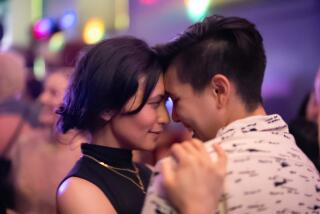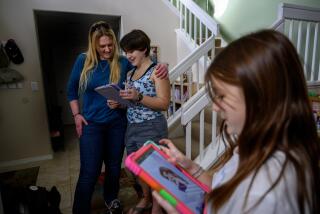Census Should Include Gay Category, Activists Argue
- Share via
When it comes to the census, Martin McCombs said, he doesn’t count.
Nevertheless, the executive director of the Gay and Lesbian Community Center of Greater Long Beach will fill out the national survey this month. He and many others also will protest by creating their own demographic category on the form, writing in that they are gay.
“If we need to know how many Laotians live here, we could find out” using the census, McCombs said. “But if we want information on gay men, we’d have to ask them to come” forward.
The protest will go unnoticed because unsolicited responses on the decennial survey will be thrown out. Census 2000, which will use 63 categories to define the nation’s racial and ethnic makeup in unprecedented detail, won’t shed any new light on its homosexual population.
“We’re talking about the ultimate undercount. You are not even on the list,” said Gwen Baldwin, executive director of the L.A. Gay and Lesbian Center.
The reason is simple: There is no legal justification for counting gay men, lesbians, bisexuals and transgender people, census experts say. Only questions with legal triggers, such as those about race that are used to enforce the Federal Voting Rights Act, make it onto the form.
Gay and civil rights officials insist there is a reason, however, because the census is used to shape federal programs and allocate funds.
A gay and lesbian count might even help fight hate crimes, said Jennifer Pizer, managing attorney of the Western regional office of the Lambda Legal Defense and Education Fund, which works to achieve civil rights for lesbians and gays. “It could help to win passage of antidiscrimination laws if [lawmakers knew how many gay] and lesbian constituents they really have.”
At least one organization--the National Gay and Lesbian Task Force--expects to campaign for including a question about sexual orientation on the 2010 form. But federal and state lawmakers approached for interviews were reluctant to discuss the idea.
It’s a “nonissue,” said state Sen. Ray Haynes, (R-Riverside), who is vying for the Republican nomination for the U.S. Senate. “What you do in the bedroom has nothing to do with government policy. . . . I don’t want to tell people what I do in the bedroom.”
Some gays and lesbians also expressed reservations. Among their concerns were undercounts that could be used by gay rights opponents to downplay the community, fear of increased discrimination and mistrust of government.
“We’re living in a scary time,” said Pizer, adding that her organization has taken no position on the census question. “We can’t expect millions of gay and lesbian Americans to come out en masse to make themselves visible and known.”
In West Hollywood last week, many gays and lesbians were more interested in why the U.S. government might want to know about their sexual orientations than why the question wasn’t on the form.
“You can be discriminated against and from that point of view, it’s better we don’t get asked,” said Monica Taher, 27, a reporter for Adelante magazine who was browsing at A Different Light bookstore on Santa Monica Boulevard. Still, if asked, she would acknowledge her sexual orientation on the form, Taher said.
So would Jim Lopala, 33, of New York City. “We should be recognized,” he said.
Canada May Accept Change
It is a sentiment gaining acceptance in Canada, where the Liberal government has begun erasing most legal differences between heterosexual and homosexual couples. Parliament will decide in the coming weeks whether to add more detailed questions on gay and lesbian households to Canada’s census forms in time for next year’s count, said Rosemary Bender, a Statistics Canada manager in Ottawa. But the U.S. Census may not be the best forum for gay recognition here, said Glenn Magpantay, Democracy Project director for the Asian American Legal Defense and Education Fund. “It has nothing to do with who is in society and what people in society look like. It has to do with how many people there are in each area for the purpose of redistricting.”
For now, Magpantay and others focus on persuading gays and lesbians to fill out the one category the bureau is tracking: “unmarried partners.” The category was added in 1990 to track unmarried heterosexual and homosexual couples who live together. A decade ago, fewer than 150,000 same-sex couples were counted in that category.
Magpantay sent a letter to the Census Bureau in November, urging officials to increase their outreach. Only a few of the 200-plus “partnerships” formed by the regional census bureau with Los Angeles community groups to get out the word about the census are with organizations that serve gays and lesbians.
Only one person formally campaigned to add a question about sexual orientation to this year’s census, according to federal officials; Thomas Duane, president of the Gay, Lesbian and Bisexual Local Officials organization, wrote the Census Bureau three years ago, requesting that such a question be included.
“Quite simply, we believe that it would be appropriate for the census form to include a question for adult members of households,” wrote Duane, now a New York state senator representing the lower and west sides of Manhattan. His suggestion, along with ones for rewording the question about unmarried partners to reduce any perception of bias against same-sex couples, were not followed.
It’s more involved than simply adding a question, however, Magpantay said. Sexual orientation is not visible the way the color of one’s skin or one’s ethnic background might be.
“How do you ask it? What is a gay person?” Magpantay asked. Is it defined by sexual experiences? Orientation?
Census officials share similar concerns.
“I don’t think it’s the kind of question that can be handled in a mail-out, mail-back survey. . . . The problem with asking the question is that it does not have a potential common ground of understanding,” said Martin O’Connell, chief of the bureau’s fertility and family statistics branch.
Adding any question is also a procedural nightmare, requiring an act of Congress or a basis in existing law.
“Each question has real political consequences,” Magpantay said. “There are tremendous battles over what questions will you continue to put in.”
In addition, a detailed review process by the White House Office of Management and Budget is directed toward shortening the form to encourage participation.
“People forget this is a country that relies very heavily on information,” said Terri Ann Lowenthal, a former staff director of the House subcommittee overseeing the census. “People forget that in order for the government to know these things and do something about them, we have to collect the information,” she said.
Such Counts Are Unusual, Low-Key
To McCombs, not counting gays goes beyond forgetfulness.
“It’s frustrating that people have an easier time grasping a sense of minority based on race and ethnicity,” the director of the Long Beach center said. “It’s as if they are saying there’s no purpose to knowing how many gays and lesbians are out there.”
There is certainly discomfort over the prospect. The U.S. government has never done such a count other than for health-related research, and even that is kept low-key.
The counting of homosexual households also has been largely unadvertised by the Census Bureau, one of the reasons why it has not presented an accurate picture, proponents said. The agency in 1990 found 81,000 male and 64,000 female households.
Members of same-sex couples who identified themselves as spouses rather than as unmarried partners were not counted, said Sean Cahill, research director at the National Gay and Lesbian Task Force.
Several nationwide surveys indicate a larger homosexual population than the bureau’s household figures indicate, however. In 1998, 4.2% of voters surveyed in Voter News Service national exit polls identified themselves as gay, lesbian or bisexual. Another study conducted in 1992 by the University of Chicago’s National Opinion Research Center found anywhere from 1.3% to 4.9% of the 3,500 adults who participated were homosexual, judging by sexual activity.
“If we assume that 3% or 5% of couples would be same-sex the number would be millions, not thousands, as the census showed,” Cahill said, adding that getting a better count is vital to identifying gay and lesbian needs and as a basis for public policy.
“On some level, it would be good to have” a broader homosexual question on the census, Magpantay said. “But we need to have more discussions over it.
“If the ultimate objective is equal rights for the gay community, that should not necessarily come because we are a small or large society,” based on the census.
More to Read
Sign up for Essential California
The most important California stories and recommendations in your inbox every morning.
You may occasionally receive promotional content from the Los Angeles Times.













